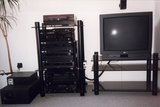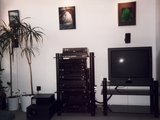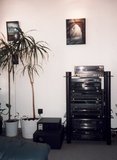Mk 1. The Pro Logic/Laserdisk Period.
Introduction
The new TV and the new video recorder had watered my appetite: In January 1994 I bought a Pro Logic receiver (Onkyo TX-SV9041), a laserdisk player (Sony MDP 650D) and, as front Left/Right/Center speakers the Bose Acoustimass 7. Surround speakers also from Bose (VS100). This (essentially) completes the setup that I refer to as Mk 1. This was a fantastic feeling. Surround sound! No-one had seen anything like the sound and picture quality of the laserdisk before. Audio and video completely integrated. Both me and my friends were deeply impressed. Except for the tiny TV-picture, it was hard to imagine anything (essentially) better. A drawback was of course the extraordinary prices and the bad availability of software in form of laserdisks: 100 DM and more were common. The disadvantage was somewhat lessened by the fact that one of Germany's largest laserdisk importers (Cinemabilia, seems to have gone out of business now) had their store located within walking distance from my apartment in Bremen. A big source of inspiration was the mailing list Europe-LD (and later Europe-DVD).
Time went on, and I started to get annoyed by the tonal quality (or, rather, lack thereof) of the Bose system. By movies, it could make a considerable amount of Ka-boom, but in particular for listening to music the un-detailed, bodiless, bass weak and colored characteristic started to get on my nerves. I learned, what amount of marketing hype goes into Bose, and what reputation its products hold on Internet (see, e.g. here.) The surround-speakers VS-100 (VS for "Video-Speaker", a name that Bose apparently have selected to mean "quality not even attempted") was a simplistic 1-Way system, with the cheapest parts possible. Not even claimed to be full-range, but a "video speaker". It is hard to imagine that the cost more than, say, 10 Euro to manufacture. Nevertheless, they cost 299 DM (German Marks; slightly more that 150 Euro) each!
To fit in optically, the Thorens turntable was painted with a matt black spray paint. (I cannot stand the walnut look of the 1970's.)
PALplus
Some years later, for a limited period of time, PALplus (a technologically quite advanced trick to send (analog) 16:9-Programs without annoying the 4:3-crowd) was considered the best thing after sliced bread, and I bought a set-top standalone decoder. (It was available under several different names, but all manufactured by Nokia.) (This, technologically not uninteresting, experiment, has been put on the historical garbage dump by digital TV. Probably very few persons (one of them is me :-) has ever taken advantage, or even noted. As far as I am aware, this experiment has probably cost the European tax- and license-payers enormous sums...
Probably not many persons (in Germany) know it, but at the time of this writing (June 2005), German public ("Öffentlich-rechtliche") TV channels (ARD, ZDF, Dritte, 3sat, arte,...) all send a considerable amount of its 16:9-Programs in PALplus: often several hours per day and channel.
Details on Mk 1. (Bremen 1994–München 2000)
- TV: Philips Matchline 28ML8805
- Loudspeakers (Left/Center/Right): Bose Acoustimass 7
- Surround Loudspeakers: Bose VS100
- Laserdisk Player: Sony MDP 650D
- Receiver Onkyo TX-SV9041
- VHS Recorder: Panasonic NV-F55EG
- Receiver: Marantz SR-60
- CD Player: Marantz CD42
- Tape Deck: Marantz SD-53
- Timer: Pioneer DT-555
- Turntable Thorens TD150/II (purchased 1972), equipped with SME Model 3009 Series II Improved Arm and ADC XLM MKII stylus.
- "Telefunken" PALplus-decoder (manufactured by Nokia)
- Premiere analog pay-tv decoder
- Stax SR-X Mark 3 electrostatic earphones, with SRD-6 adapter. Purchased in 1982.
- Remote Control: Many, e.g. Lapeschi Telegenius
Kitchen, Bedroom, and Computer
The kitchen and the bedroom were powered from the Marantz SR-60 amplifier. The kitchen had two IQ Mini Lady Loudspeakers, while the bedroom was equipped with homebuilt so-called Voigt-horns with Louther elements. These were connected in parallel.
For the computer desk, a pair of JBL Control 1G speakers were used, connected as the secondary speaker pair of the Onkyo.
Photos (Bremen 1999)
Continue to Mk 2. The 5.1/DVD Period.






